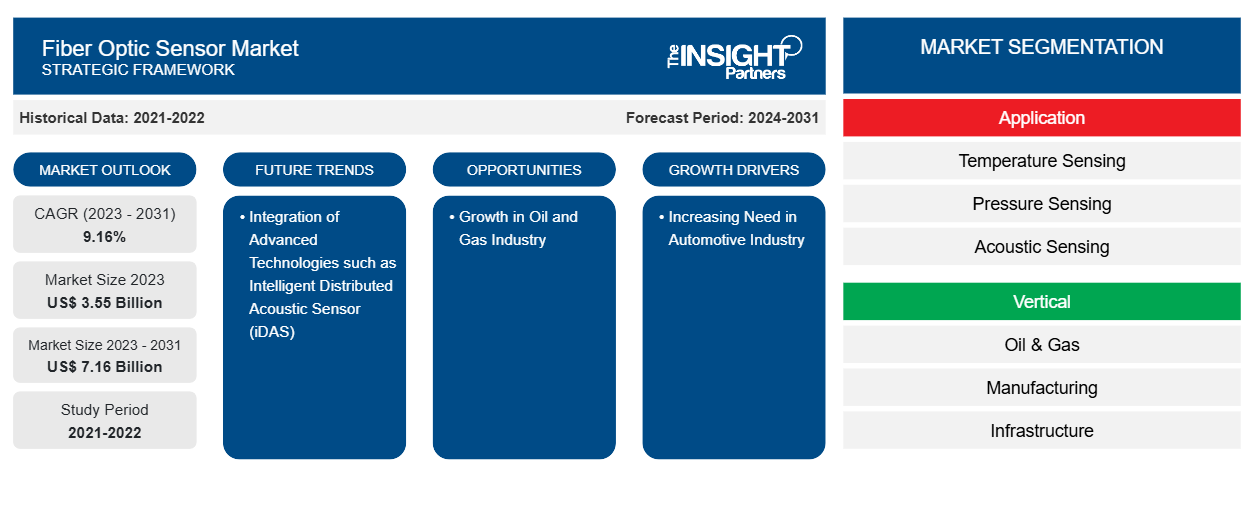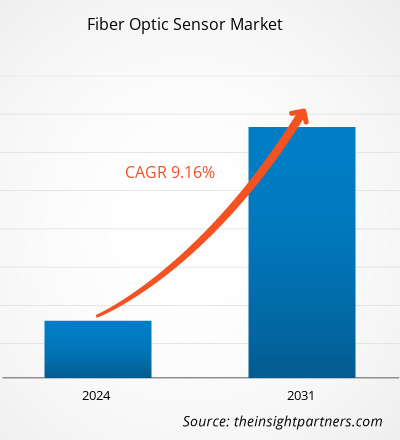من المتوقع أن يصل حجم سوق مستشعرات الألياف الضوئية إلى 6.76 مليار دولار أمريكي بحلول عام 2031، مقارنةً بـ 3.61 مليار دولار أمريكي في عام 2024. ومن المتوقع أن يسجل السوق معدل نمو سنوي مركب قدره 9.7% خلال الفترة 2025-2031. ومن المرجح أن يُسهم التصغير وسهولة النقل في ظهور اتجاهات جديدة في السوق خلال السنوات القادمة.
تحليل سوق أجهزة استشعار الألياف البصرية
الاستشعار بالألياف الضوئية تقنية تُستخدم لقياس التغيرات الكيميائية، والإجهاد، ودرجة الحرارة، والمجالات الكهربائية والمغناطيسية، والضغط، والإزاحة، والدوران، والإشعاع، ومستوى السائل، والتدفق، وشدة الضوء، والاهتزازات. مستشعر الألياف الضوئية هو جهاز يستخدم الألياف الضوئية إما لاكتشاف التغيرات في البيئة (وتسمى المستشعرات الداخلية) أو لنقل الإشارات من مستشعر بعيد إلى معدات المعالجة (وتسمى المستشعرات الخارجية). تُستخدم هذه المستشعرات الصغيرة بشكل شائع في الاستشعار عن بُعد نظرًا لعدة مزايا. فهي لا تتطلب طاقة كهربائية عند نقطة الاستشعار، ويمكن للألياف الضوئية الواحدة دعم أجهزة استشعار متعددة. هذه المزايا تجعلها فعالة من حيث التكلفة وفعّالة لمراقبة العمليات لمسافات طويلة. تتميز مستشعرات الألياف الضوئية بالمتانة ويمكنها العمل في درجات حرارة عالية. ولأنها لا تحمل الكهرباء، فإنها تعمل بشكل جيد أيضًا في المناطق ذات التداخل الكهربائي العالي، أو الجهد العالي، أو المواد القابلة للاشتعال؛ مما يجعلها مثالية للاستخدام في صناعات مثل النفط والغاز، والبناء، والفضاء، والرعاية الصحية.
نظرة عامة على سوق أجهزة استشعار الألياف البصرية
تُعدّ التطبيقات المتزايدة في قطاع النفط والغاز، والطلب المتزايد على أنظمة مراقبة سلامة المنشآت (SHM) في مختلف القطاعات، من العوامل الرئيسية التي تُعزز سوق مستشعرات الألياف الضوئية. تلعب هذه المستشعرات دورًا حاسمًا في تحسين السلامة والكفاءة في المباني وخطوط الأنابيب وأنظمة النقل. كما تتبنى قطاعات مثل النفط والغاز والطاقة والاتصالات تقنيات الاستشعار هذه لتحسين الأداء والموثوقية. ومع توجه المزيد من الصناعات نحو الأتمتة والأنظمة الذكية، من المتوقع أن ينمو سوق مستشعرات الألياف الضوئية العالمي بشكل مطرد في السنوات القادمة. وسيؤدي تطوير المدن الذكية ونمو قطاع الطاقة المتجددة إلى خلق فرص مربحة في السوق في المستقبل القريب.
ستحصل على تخصيص لأي تقرير - مجانًا - بما في ذلك أجزاء من هذا التقرير، أو تحليل على مستوى الدولة، وحزمة بيانات Excel، بالإضافة إلى الاستفادة من العروض والخصومات الرائعة للشركات الناشئة والجامعات
سوق أجهزة استشعار الألياف البصرية: رؤى استراتيجية

- احصل على أهم اتجاهات السوق الرئيسية لهذا التقرير.ستتضمن هذه العينة المجانية تحليل البيانات، بدءًا من اتجاهات السوق وحتى التقديرات والتوقعات.
محركات وفرص سوق أجهزة استشعار الألياف البصرية
الطلب المتزايد على مراقبة الصحة الهيكلية
يتزايد التركيز على سلامة البنية التحتية والمراقبة الآنية في جميع أنحاء العالم، مما يدفع الطلب على أنظمة مراقبة الصحة الإنشائية المتقدمة (SHM). مع توسع المدن الحديثة وتقادم البنية التحتية، هناك حاجة مستمرة للكشف عن العلامات المبكرة للتلف أو الفشل في الهياكل مثل الجسور والأنفاق والسدود والمباني. غالبًا ما تقصر الأنظمة التقليدية مثل مقاييس الانفعال المقاومة من حيث المتانة والدقة على المدى الطويل والقدرة على التكيف. وقد برزت أجهزة استشعار الألياف الضوئية كبديل متفوق لأنظمة المراقبة التقليدية، حيث توفر مزايا مثل التصميم المدمج ومقاومة التآكل وتحمل التداخل الكهرومغناطيسي. علاوة على ذلك، فإن قدرتها على الدمج مباشرة في الهياكل تزيد من شعبيتها. هذه الصفات تجعلها مثالية لمراقبة الصحة الإنشائية طويلة المدى، حتى في البيئات الصعبة. يمكن لهذه المستشعرات قياس المعلمات الفيزيائية الرئيسية بدقة مثل الانفعال ودرجة الحرارة والاهتزاز والميل، وهي ضرورية للحفاظ على سلامة البنية التحتية وسلامتها.
لتلبية الطلب المتزايد، تسعى الشركات في سوق مستشعرات الألياف الضوئية إلى تأمين استثمارات لتوسيع نطاق تقنياتها. على سبيل المثال، نجحت شركة سينتيا، وهي شركة فرعية من شركة إيميك ومورد لأنظمة قراءة مستشعرات الألياف الضوئية، في جمع حوالي 2.6 مليون دولار أمريكي (2.3 مليون يورو) في عام 2021 لتوسيع أعمالها. أُعلن عن هذا الاستثمار في أكتوبر 2021. بدعم من مستثمرين مثل فينيندوس، وPMV، وQBIC II، وفيديميك، تركز مبادرة سينتيا التوسعية على تطوير تقنية التكامل الفوتوني لتمكين استشعار الألياف الضوئية على نطاق واسع في مجالات الهندسة المدنية، والنفط والغاز، والطاقة المتجددة، والتطبيقات الطبية. تعكس هذه الاستثمارات الإمكانات المتنامية لنشر تقنية استشعار الألياف الضوئية في تطبيقات إدارة النفايات الصلبة، مما يُعزز نمو سوق مستشعرات الألياف الضوئية.
تطوير المدن الذكية
أطلقت الحكومة الهندية مبادرة "100 مدينة ذكية" في 25 يونيو 2015، بهدف تطوير 100 مدينة في جميع أنحاء البلاد ببنية تحتية حديثة، وبيئة نظيفة ومستدامة، وتحسين جودة الحياة من خلال استخدام الحلول الذكية. وتعزز هذه المبادرة التنمية الحضرية الشاملة - الاجتماعية والاقتصادية والمادية والمؤسسية - في إطار برنامج برعاية مركزية بتمويل مركزي يقارب 6,400 مليون دولار أمريكي (48,000 كرور روبية هندية)، وتدعمه الولايات ومصادر أخرى، بما في ذلك الشراكات بين القطاعين العام والخاص. وتسعى المبادرة إلى بناء نماذج قابلة للتكرار للنمو الحضري المستدام والشامل، لتتبعها مدن أخرى. وفي الاتحاد الأوروبي، تدعم مبادرة "NetZeroCities" مبادرة "100 مدينة ذكية ومحايدة مناخيًا بحلول عام 2030" كجزء من برنامج "أفق أوروبا".
مع توسّع المدن الذكية، ستزداد الحاجة إلى أدوات مراقبة متطورة، مثل مستشعرات الألياف الضوئية. تُوفّر هذه المستشعرات بيانات آنية، وتعمل بكفاءة في البيئات القاسية، مع ضمان استمرارية العمل. يُمكن استخدامها لمراقبة الجسور والطرق والأنفاق والمباني وأنابيب المياه وأنظمة الطاقة. على سبيل المثال، يُمكنها اكتشاف الشقوق في الجسور، أو التسريبات في الأنابيب، أو التغيرات في درجات الحرارة في شبكات الكهرباء، مما يُساعد سلطات المدينة على اتخاذ الإجراءات اللازمة قبل تفاقم المشاكل. كما يُمكن استخدام هذه المستشعرات في أنظمة المرور الذكية، والشبكات الذكية، والمباني الذكية، حيث تُساعد على تحسين الأداء والسلامة. وبالتالي، يُتيح تنامي المدن الذكية فرصةً واعدةً لسوق مستشعرات الألياف الضوئية، إذ تُساعد هذه المستشعرات في بناء أنظمة متصلة وفعالة.
تقرير تحليل تجزئة سوق أجهزة استشعار الألياف البصرية
القطاعات الرئيسية التي ساهمت في اشتقاق تحليل سوق أجهزة استشعار الألياف البصرية هي نوع الاستشعار والمستخدم النهائي والتطبيق.
- بناءً على نوع الاستشعار، يُقسّم سوق مستشعرات الألياف الضوئية إلى استشعار درجة الحرارة، واستشعار الضغط، والاستشعار الصوتي، واستشعار الإجهاد، وغيرها. وقد استحوذ قطاع استشعار درجة الحرارة على الحصة الأكبر من السوق في عام ٢٠٢٤.
- بناءً على المستخدم النهائي، يُقسّم سوق مستشعرات الألياف الضوئية إلى قطاعات النفط والغاز، والتصنيع، والبنية التحتية، والفضاء والدفاع، والطاقة والمرافق، وغيرها. وقد استحوذ قطاع النفط والغاز على الحصة السوقية الأكبر في عام ٢٠٢٤.
- بناءً على التطبيق، يُقسّم سوق مستشعرات الألياف الضوئية إلى: مراقبة كابلات الجهد العالي أو الطاقة العالية، ومراقبة خطوط الأنابيب ، والتطبيقات الأولية، وكشف الحرائق في الأصول الحيوية، وتطبيقات احتجاز الكربون وتخزينه/احتجازه واستخدامه (CCS/CCUS)، وغيرها. وقد استحوذت قطاعات أخرى على أكبر حصة سوقية في عام ٢٠٢٤.
تحليل حصة سوق أجهزة استشعار الألياف البصرية حسب المنطقة الجغرافية
ينقسم النطاق الجغرافي لتقرير سوق مستشعرات الألياف الضوئية بشكل رئيسي إلى خمس مناطق: أمريكا الشمالية، وآسيا والمحيط الهادئ، وأوروبا، والشرق الأوسط وأفريقيا، وأمريكا الجنوبية والوسطى. وقد استحوذت منطقة آسيا والمحيط الهادئ على حصة سوقية كبيرة في عام 2024.
رؤى إقليمية حول سوق أجهزة استشعار الألياف البصرية
قام محللو شركة إنسايت بارتنرز بشرح شامل للاتجاهات الإقليمية والعوامل المؤثرة في سوق مستشعرات الألياف الضوئية خلال فترة التوقعات. ويناقش هذا القسم أيضًا قطاعات سوق مستشعرات الألياف الضوئية ونطاقها الجغرافي في أمريكا الشمالية، وأوروبا، وآسيا والمحيط الهادئ، والشرق الأوسط وأفريقيا، وأمريكا الجنوبية والوسطى.

- احصل على البيانات الإقليمية المحددة لسوق أجهزة استشعار الألياف البصرية
نطاق تقرير سوق أجهزة استشعار الألياف البصرية
| سمة التقرير | تفاصيل |
|---|---|
| حجم السوق في عام 2024 | 3.61 مليار دولار أمريكي |
| حجم السوق بحلول عام 2031 | 6.76 مليار دولار أمريكي |
| معدل النمو السنوي المركب العالمي (2025 - 2031) | 9.7% |
| البيانات التاريخية | 2021-2023 |
| فترة التنبؤ | 2025-2031 |
| القطاعات المغطاة | حسب نوع الاستشعار
|
| المناطق والدول المغطاة | أمريكا الشمالية
|
| قادة السوق وملفات تعريف الشركات الرئيسية |
|
كثافة اللاعبين في سوق أجهزة استشعار الألياف الضوئية: فهم تأثيرها على ديناميكيات الأعمال
يشهد سوق مستشعرات الألياف الضوئية نموًا سريعًا، مدفوعًا بتزايد طلب المستخدمين النهائيين نتيجةً لعوامل مثل تطور تفضيلات المستهلكين، والتقدم التكنولوجي، وزيادة الوعي بمزايا المنتج. ومع تزايد الطلب، تعمل الشركات على توسيع عروضها، والابتكار لتلبية احتياجات المستهلكين، والاستفادة من الاتجاهات الناشئة، مما يُعزز نمو السوق.
تشير كثافة اللاعبين في السوق إلى توزيع الشركات أو المؤسسات العاملة في سوق أو قطاع معين. وتشير إلى عدد المنافسين (اللاعبين في السوق) الموجودين في سوق معين نسبةً إلى حجمه أو قيمته السوقية الإجمالية.
الشركات الرئيسية العاملة في سوق أجهزة استشعار الألياف البصرية هي:
- شركة باومر القابضة
- بيبرل+فوكس إس إي
- شركة وينجلور سينسوريك المحدودة
- شركة NEC
- بروكسيميون AB
- شركة أومرون
إخلاء المسؤولية : الشركات المذكورة أعلاه ليست مرتبة بأي ترتيب معين.

- احصل على نظرة عامة على أهم اللاعبين الرئيسيين في سوق أجهزة استشعار الألياف البصرية
أخبار سوق أجهزة استشعار الألياف البصرية والتطورات الأخيرة
يُقيّم سوق مستشعرات الألياف الضوئية بجمع بيانات نوعية وكمية بعد البحث الأولي والثانوي، والتي تشمل منشورات الشركات المهمة، وبيانات الجمعيات، وقواعد البيانات. فيما يلي بعض التطورات في السوق:
قدمت شركة وينجلور مُضخّم الألياف الضوئية P1XD، المُصمّم خصيصًا لتطبيقات المساحات الصغيرة. تُوفّر طُرز سلسلة P1XD2 خيارات تكامل مرنة، مما يسمح للمُضخّم بالعمل بشكل مستقل أو كجزء من نظام شبكي، سواءً كنظام رئيسي أو تابع. (المصدر: وينجلور، بيان صحفي، ديسمبر 2024)
أطلقت شركتا هانيويل (ناسداك: HON) وسيفيتانافي سيستمز (يورونيكست ميلان: CNS) وحدة قياس جديدة بالقصور الذاتي للعملاء التجاريين والدفاعيين حول العالم. تتكون سلسلة HG2800 من وحدات قياس بالقصور الذاتي منخفضة الضوضاء، عالية النطاق الترددي، عالية الأداء، وتكتيكية، مصممة للتوجيه والتثبيت والملاحة قصيرة المدى على الطائرات التجارية والعسكرية، من بين تطبيقات أخرى. (المصدر: هانيويل، بيان صحفي، سبتمبر 2023)
تغطية تقرير سوق أجهزة استشعار الألياف الضوئية والمنتجات النهائية
يقدم تقرير "حجم سوق أجهزة استشعار الألياف الضوئية والتوقعات (2021-2031)" تحليلاً مفصلاً للسوق يغطي المجالات التالية:
- حجم سوق أجهزة استشعار الألياف البصرية وتوقعاتها على المستويات العالمية والإقليمية والوطنية لجميع قطاعات السوق الرئيسية التي يغطيها النطاق
- اتجاهات سوق أجهزة استشعار الألياف الضوئية، بالإضافة إلى ديناميكيات السوق مثل العوامل المحركة والقيود والفرص الرئيسية
- تحليل مفصل لـ PEST و SWOT
- تحليل سوق أجهزة استشعار الألياف البصرية الذي يغطي اتجاهات السوق الرئيسية والإطار العالمي والإقليمي والجهات الفاعلة الرئيسية واللوائح والتطورات الأخيرة في السوق
- تحليل المشهد الصناعي والمنافسة الذي يغطي تركيز السوق، وتحليل خريطة الحرارة، واللاعبين البارزين، والتطورات الأخيرة في سوق أجهزة استشعار الألياف البصرية
- ملفات تعريف الشركة التفصيلية
- التحليل التاريخي (سنتان)، سنة الأساس، التوقعات (7 سنوات) مع معدل النمو السنوي المركب
- تحليل PEST و SWOT
- حجم السوق والقيمة / الحجم - عالمي، إقليمي، بلد
- الصناعة والمنافسة
- مجموعة بيانات إكسل
التقارير الحديثة
شهادات العملاء
سبب الشراء
- اتخاذ قرارات مدروسة
- فهم ديناميكيات السوق
- تحليل المنافسة
- رؤى العملاء
- توقعات السوق
- تخفيف المخاطر
- التخطيط الاستراتيجي
- مبررات الاستثمار
- تحديد الأسواق الناشئة
- تحسين استراتيجيات التسويق
- تعزيز الكفاءة التشغيلية
- مواكبة التوجهات التنظيمية




















 احصل على عينة مجانية ل - سوق أجهزة استشعار الألياف البصرية
احصل على عينة مجانية ل - سوق أجهزة استشعار الألياف البصرية